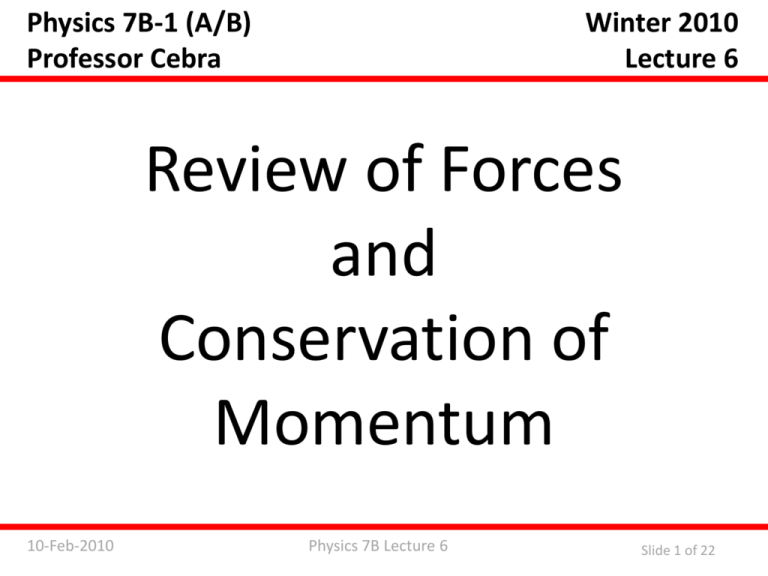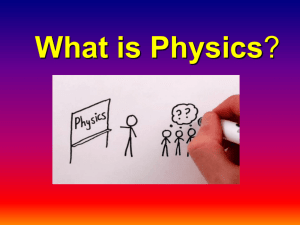Lecture6_7B_W10 - Nuclear Physics Group
advertisement

Physics 7B-1 (A/B) Professor Cebra Winter 2010 Lecture 6 Review of Forces and Conservation of Momentum 10-Feb-2010 Physics 7B Lecture 6 Slide 1 of 22 Vector Addition and Subtraction Vectors are added head to tail Note: a+b = b+a Vectors are subtracted by added –b to vector a Note: a-b does not equal b-a (a-b) = -(b-a) -b a a-b 10-Feb-2010 Physics 7B Lecture 6 Slide 2 of 22 The Vectors of Kinematics • Position: r dr v ins • Velocity: dt dv • Acceleration: a ins dt • Momentum: p mv • Force: 10-Feb-2010 FA on B Physics 7B Lecture 6 Slide 3 of 22 Newton’s Laws of Motion • 1st Law: The velocity of an object will not change unless acted upon by a force • 2nd Law: The net force on an object is equal to the rate of change of momentum • 3rd Law: For every force there is an equal but opposite force 10-Feb-2010 Physics 7B Lecture 6 Slide 4 of 22 Types of Force • Contact forces: Require physical contact between two objects (action and reaction) – Friction force: Acts parallel to contact surface – Normal force: Acts perpendicular to contact surface • Long-range forces: Require presence of a field between two objects (action at a distance) – Gravitational force: Exerted by one massive object on another massive object – Electrostatic force: Exerted by one charged object on another charged object 10-Feb-2010 Physics 7B Lecture 6 Slide 5 of 22 Long Range Force -- Fg= Gm1m2/r2 – Gravitational mM FG G 2 rˆ r F M m r Note: Gravity is always attractive G = 6.67 x 10-11 Nm2/kg2 “universal gravitational constant” M = mass of the object which creates the field m = mass of the object which experiences the field r = distance between m and M (pointing from M to m) 10-Feb-2010 Physics 7B Lecture 6 Slide 6 of 22 Long Range Force -- Fe=kq1q2/r2 -- Electromagnetic qQ FE k 2 rˆ r F q Q r Note: Opposites attract, like signs repel k = 9.0 x 109 Nm2/C2 “universal electric constant” Q = charge of the object which creates the field q = charge of the object which experiences the field r = distance between q and Q 10-Feb-2010 Physics 7B Lecture 6 Slide 7 of 22 Force Diagram • What are the forces on Alice? • What are the forces on Bob? Fnormal on A FB on A FA on B = -FB on A Fgravity on A Ffriction on A 10-Feb-2010 Physics 7B Lecture 6 Slide 8 of 22 Definition of Momentum Definition of Impulse Net force and Net Impulse Momentum of a system of particles Momentum Conservation Collisions Elastic Newton’s 3rd Law Inelastic Relationships Representations Introduction of Angular Momentum 10-Feb-2010 Physics 7B Lecture 6 Demos: Cart track Water Rockets Cart with fan Ball on a string Hockey pucks Rubber Ball/Clay Ball Newton’s Cradle Slide 9 of 22 The Definition of Momentum Previously we considered forces. Newton’s first law or Gallileo’s law of inertia states that in the absence of external forces, a body at rest will stay at rest and a body in motion will continue to move with the same inertia. Here will define the unchanged quantity to be the Note that p is a vector momentum (p), where p mv with three components. Demo: Air puck Recall that energy = (1/2)mv2 10-Feb-2010 Physics 7B Lecture 6 Slide 10 of 22 The Definition of Impulse Recall that work was resulted in a change in energy, where work is x W F ( x) dx E f Ei E f xi We can similarly define a quantity called the impulse, which is the time integral o f the applied force t J F (t )dt p f pi p f ti J is a vector quantity, which is applied to the vector p. 10-Feb-2010 Physics 7B Lecture 6 Demo: Air puck Slide 11 of 22 Conservation of Momentum NetJ ext J ext Fext (t )dt p f pi psystem If the net external impulse in a given direction acting on the system is zero, then there is no change in the linear momentum of the system in that direction; Otherwise there is a change in the momentum equal to the net external impulse. Conservation of Momentum! Demo: Cart with sail Compare to conservation of Energy 10-Feb-2010 Physics 7B Lecture 6 Slide 12 of 22 The Newton’s Cradle •Conservation of momentum •Newton’s 3rd Law 10-Feb-2010 Physics 7B Lecture 6 Slide 13 of 22 Rockets How does a rocket exhibit conservation of momentum? No external forces – shouldn’t p = 0? The rocket expels propellant at a high velocity backwards. Net forward p of the rocket must equal the net backward p of the propellant. • Discuss pressure • Bernoulli’s principle • Add water to rocket 10-Feb-2010 Demo: Rockets Physics 7B Lecture 6 Slide 14 of 22 Collisions A collision occurs when two free bodies make contact. The contact results in a repulsive normal force. The magnitude of the force and the duration of the contact will determine the resulting impulse. Newton’s 3rd law indicates that each of the two participating bodies will experience an equal but opposite impulse. All collisions conserve both energy and momentum, however we classify collisions as being either elastic on inelastic based upon whether kinetic energy is conserved. Elastic collisions conserve both momentum and kinetic energy. In an inelastic collision some of the energy of the collisions is dissipated as internal energy within the bodies. In a completely inelastic collision, the two bodies stick together and there is only center of mass motion remaining after the collision Demo: Rubber Ball and Clay Ball 10-Feb-2010 Physics 7B Lecture 6 Slide 15 of 22 1D Elastic Collisions Elastic Collisions: KEi KE f ptot,i ptot, f Try cases of: Equal masses • M1>m2 • m1<M2 • v1>v2 • v1<v2 Demo: collision table 10-Feb-2010 Physics 7B Lecture 6 Slide 16 of 22 The Definition of Momentum Inelastic Collisions: KEi KE f ptot,i ptot, f Try cases of: Equal masses • M1>m2 • m1<M2 • v1>v2 • v1<v2 Demo: collision table 10-Feb-2010 Physics 7B Lecture 6 Slide 17 of 22 10-Feb-2010 Physics 7B Lecture 6 Slide 18 of 22 Inelastic Collisions 10-Feb-2010 Physics 7B Lecture 6 Slide 19 of 22 2D Collisions Demo: Air puck 10-Feb-2010 Physics 7B Lecture 6 Slide 20 of 22 Many Body Problem 10-Feb-2010 Physics 7B Lecture 6 Slide 21 of 22 Angular Momentum Fc = mv2/r F Spin the ball, then let it go. Due to conservation of momentum, it must go in the straight line P Demo: Ball on a string 10-Feb-2010 Physics 7B Lecture 6 Slide 22 of 22 Announcements President’s day Holiday - Monday 10-Feb-2010 Physics 7B Lecture 6 Slide 23 of 22 DL Sections 10-Feb-2010 Physics 7B Lecture 6 Slide 24 of 22







